おすすめの Google 拡張機能です!新しい言葉を勉強しましょう!
Here are the recommended Chrome extensions! Let’s learn new words here!
ポッドキャストプラットフォーム|Platforms of Podcast
こちらの記事は、配信中のポッドキャストのスクリプトです。
ぜひ、ポッドキャストを聞きながら読んでください。
 えみ先生
えみ先生もう聞いた人は、クイズをチェックしましょう!
ちょっとクイズ!|CHOTTO Quiz!
ポッドキャストを聞いた人は、ちょっとクイズを解いてみましょう。
むずかしいときは、下のスクリプトを読んで、もう一度クイズをチェックしてみてください。
【えいご】English Translation
Answer these quiz questions if you’ve listened to a new episode of my podcast.
If it was difficult, read the transcript below and try again.
❓ 日本の学校では、髪を染めてもいいですか?|In Japanese schools, is it okay to dye your hair?
いいえ、染めてはいけません。🙅♀️💇♀️
No, you are not allowed to dye your hair.
❓ 日本の学校では、誰が掃除をしますか? | In Japanese schools, who does the cleaning?
学生が掃除をします。🧑🎓👩🎓👨🎓
The students do the cleaning.
❓ えみ先生の学校の昼休みは 何時からでしたか? | What time did lunchtime at Emi-sensei’s school start in Japanese schools?
えみ先生の学校は、午後1時からでした。🍱
It started at 1:00 PM at Emi-sensei’s school.
ポッドキャストのスクリプト|Transcript of Podcast
エピソード13、「日本の学校のルール」
このポッドキャストは、初中級(Pre-Intermediate)レベルです。
おはようございます。こんにちは。こんばんは。
日本語の先生、エミです。
最近、少しずつ 暖かくなってきましたね。
でも、いつもより寒い時期が ちょっと長かったです。
だから、桜が 咲くのも 少し遅れています。
だけど、私は 今週の水曜日に桜を見に行ってきました。
桜は、まだ 40パーセントぐらいしか 咲いていませんでしたけど、それでも きれいでしたよ。
みなさんも、もし 3月から4月ぐらい、春に日本に来たら、ぜひ桜を見に行ってみてくださいね。
【えいご】English Translation
Good morning. Hello. Good afternoon.
I am a Japanese teacher, Emi.
Recently, it’s been getting warmer little by little.
But the cold season lasted a bit longer than usual.
That’s why the cherry blossoms are blooming a little later this year.
However, I went to see the cherry blossoms this (meaning “last” here) Wednesday.
Only about 40% of the cherry blossoms had bloomed yet, but they were still beautiful.
If you come to Japan in the spring, around March or April, please try to go see the cherry blossoms!
はい、じゃあ ここで先週の質問をチェックしましょう。
先週は こんな質問をしました。
「みなさんは、日本の学校のルール 知っていますか?
日本の中学校、高校のルールで知っていること、おどろいたことはありますか?」
こんな質問でした。
今日は、日本の学校のルールと私が高校生だったときの スケジュールについて話します。
まず、語彙チェックをしましょう。
ボキャブラリーチェックですね。
今日は 7つあります。7つの新しい言葉です。
【えいご】English Translation
Alright, now let’s check last week’s question.
Last week, I asked this question:
“Do you know the rules of Japanese schools?
Are there any rules from Japanese middle or high schools that you know or were surprised by?”
That was the question.
Today, I will talk about Japanese school rules and my high school schedule.
First, let’s do a Goi check.
It is a Vocabulary check.
There are seven new words today.
1「男子」
男子は、男の子のことです。
特に学生の男の子のことを 男子と言います。
2「女子」
これは 女の子のことです。
特に、学生の女の子のことを 女子と言います。
【えいご】English Translation
1. Danshi (男子)
This means “boys,” especially students who are boys.
2. Joshi (女子)
This means “girls,” especially students who are girls.
3「禁止」
してはいけないことです。
たとえば、タバコ禁止は、タバコを吸ってはいけません。
「飲食禁止」
飲食は飲むこと、食べることです。
だから、食べたり飲んだりしてはいけません。
これが 禁止です。
【えいご】English Translation
3. Kinshi (禁止)
This means “something you cannot do. (“prohibited” or “not allowed.”)
For example, “Tabacco Kinshi” means you are not allowed to smoke.
“Insyoku Kinshi“
“Insyoku” means eating and drinking.
So, it means you are not allowed to eat or drink.
This is what “kinshi” means.
4「制服」
制服は、スクールユニフォームです。
学校に行くときに着る学校のオリジナルの服です。
日本の中学校と高校は制服が あるところが多いと思います。
5「部活」
部活は、学校…、授業が終わった後にするスポーツやアクティビティのことです。
野球部、サッカー部、吹奏楽部(音楽の部活)ですね。
美術部(アートの部活)…。
こんな部活があります。
【えいご】English Translation
4. Seifuku (制服)
This means “school uniform.”
It is the original uniform that students wear when going to school.
Many Japanese middle and high schools have uniforms.
5. Bukatsu (部活)
This refers to after-school sports or activities.
For example, baseball club, soccer club, wind instrument club (a music club), and art club.
We have these kinds of club activities.
6「登校」そして「下校」
登校は学校に行くことです。
朝 8時半に登校します。
そして、下校は学校から帰ることです。
夕方 5時に下校します。
登校と下校ですね。
【えいご】English Translation
6. Tookoo (登校) & Gekoo (下校)
“Tookoo” means “going to school.”
For example, “I go to school at 8:30 in the morning.”
“Gekoo” means “going home from school.”
For example, “I go home from school at 5:00 in the evening.”
This is “Tookoo” and “Gekoo.”
そして最後の言葉。
7「〜(なになに)校時」です。
〜校時は、授業の順番を数えるときに使います。
たとえば、1日のはじめの授業は 1校時で、次は2校時、3校時、4校時と授業があります。
【えいご】English Translation
And this is the last vocabulary.
7. ~ Kooji (~校時)
This is used to count the order of classes (meaning “period”).
For example, the first class of the day is “1-kooji,” then “2-kooji,” “3-kooji,” and “4-kooji.”
はい、これで語彙チェックは 終わりです。
では、日本の学校のルールについて話していきましょう。
日本の学校は ほかの国と比べると ちょっと変わった不思議なルールが あると思います。
まずは、男女共通のルールをチェックしましょう。
男女は 男と女、共通は同じという意味です。
男子と女子で同じルールをチェックしましょう。これは 4つあります。
【えいご】English Translation
Alright, that’s the end of the vocabulary check.
Now, let’s talk about Japanese school rules.
I think Japanese schools have some unique and unusual rules compared to other countries.
First, let’s check the rules that apply to both boys and girls “Danjo Kyootsuu“.
“Danjo” is a combined word with “Danshi” and “Joshi.”
“Kyōtsū” means “common/same,” so these are the rules that apply to both boys and girls.
There are four of them.
まず 1つ目。
1.制服を きれいに着る
日本の学校は制服、スクールユニフォームがありますね。
でも、その制服は おしゃれに着ることはできません。
オシャレ、Stylishとかfashionableですね。
オシャレじゃなくて、正しい着方をしなければいけません。
スカートの長さ、ズボンの長さ、これもルールがあるので、ルールを守って制服を着ます。
ちょっと短くしたり、長くしたりすると 先生から怒られます。
だから学校では あんまり おしゃれはできませんね。
これが、1、制服を きれいに着る
【えいご】English Translation
First of all,
1. Wearing the uniform properly
Japanese schools have uniforms.
But students are not allowed to wear them in a stylish way.
“Osyare” means stylish or fashionable.
You have to wear them properly, not in a stylish way.
There are rules about the length of skirts and pants.
If you make them shorter or longer, teachers will scold you.
So, you can’t really be fashionable at school.
This is the first rule, wearing the uniform properly.
そして2つ目。
髪を染められない
染めるは to dye hairですね。
To dye my hair、to dye your hairです。
日本の学校では、髪の毛を 自分の好きな色に することができません。
たとえば、ピンクが好きだから ピンクに染めますとか、アニメのあのキャラクターが好きだから 髪の毛を青にしますとか…、できません。
自分の髪が もともと明るいとき、生まれたときから ちょっと明るいとき、最初から茶色ですとか、最初からブロンドですっていうときは、学校に証明書を書かなければいけないときもあります。
証明書は、私の髪は 昔から明るいです。これを紙に書いて学校に出します。
ちょっと きびしいですね。これが 2つ目。
【えいご】English Translation
And the second rule is;
2. No dyeing hair
“Someru” means to dye (my/your) hair.
In Japanese schools, you can’t dye your hair any color you like.
For example, you can’t dye it pink because you like pink, or dye it blue because you like an anime character.
If your natural hair is already light brown or blonde, you may need to submit a certificate to the school.
We have to prove it somehow and write it on paper, then submit it to the school.
It is a little strict. But this is the second one.
そして 3つ目。
学校に持ってきてはいけないものがあるんです。
私が中学校のときは、スマホを持ってきてはいけませんでした。
スマホを持っている人たちもいましたけど…、でも、学校には持ってきてはいけませんでした。
そしてあと、お菓子も中学校は ダメでしたね。
高校は大丈夫でしたけど…、もちろん お昼ご飯のときだけ 食べてもいいです。
私が 18歳のとき、アメリカに留学したんですけど、そのとき授業中に お菓子を食べている学生がいたので、そのときは とてもびっくりしました。
あと、日本は ガムもダメです。
授業中もダメだし、たぶん お昼休みも あんまりガムは良くないですね。
そして、持ってきてはいけないもの、あと1つ。これはゲームです。
ゲームは、中学校でも 高校でも どの学校も持ってきてはいけません。
学校は勉強をする場所ですから、ゲームを持ってきたら 先生に怒られます。
はい、これが 3つ目。学校に持ってきてはいけないものですね。
【えいご】English Translation
And the third rule is;
3. No bringing certain items to school
When I was in middle school, we weren’t allowed to bring smartphones.
There are some people who own their smartphone, but they couldn’t bring it to school.
Also, snacks were not allowed in middle school, but they were okay in high school during lunchtime.
But you can only have them for lunchtime of course.
When I was 18 years old, I studied abroad in the U.S. and I was very surprised to see some students eating snacks during class at that time.
Chewing gum was not allowed at all. During classes and even during lunchtime.
And one more thing you’re not allowed to bring, games.
Bringing games to school was also prohibited in both middle and high school.
Schools are meant to be somewhere to study, so you’d be get scolded by Sensei.
Yes, this is the third one; things you cannot bring to school.
そして最後の男女共通のルール、4。
4つ目は アルバイト禁止です。
ほとんどの学校は アルバイトが禁止だと思います。
でも、みんなアルバイトをしたい人が多いので、先生に相談して話して オッケーをもらってアルバイトをしている人が多いですね。
はい、これが男女共通。男子と女子で同じルールです。
【えいご】English Translation
And the last common rule both for boys and girls.
4. No part-time jobs
Most schools prohibit part-time jobs.
But there are many students who want to work part-time, so they ask the teacher for permission.
Yes, these are the rules both for boys and girls.
じゃあ次は、男子だけの ルールをチェックしてみましょう。
2つ 考えました。
【えいご】English Translation
Now, let’s look at rules for boys only.
There are two.
1つは、「ツーブロック」という ヘアスタイルが禁止でした。
ツーブロックというヘアスタイル、ちょっと調べてみてください。
ツーブロックは、髪が上は ちょっと長いんですけど、下の方は髪を剃ります。
髪がないです。
このヘアスタイルが禁止でした。
これはたぶん、ちょっと不良みたい…、
不良は悪い人という意味ですけど、不良みたいだから ダメという理由が多いと思います。
はい。
【えいご】English Translation
1. Two-block(undercut) hairstyles are not allowed
This haircut called “two-block” was prohibited. (when I was a student)
Please look it up how it looks.
A “two-block” hairstyle (undercut) is when the top is long, but the sides and back are shaved short.
This is often banned because it looks like a “bad boy” style.
そして、あと、2つ目は、長い髪が禁止ですね。
男子の長い髪は禁止でした。
理由は、たぶん きれいじゃないからですね。
あんまり清潔じゃないから、長い髪は禁止というところが多いと思います。
これも ちょっと変なルールですね。
これが男子のルールです。
【えいご】English Translation
And having long hair was also prohibited.
But only for boys.
2. Long hair is not allowed for boys
The reason is because it is considered not clean.
I think they (the school) say having long hair for boys is not clean as their reason.
This is a bit of a weird rule, isn’t it?
These are the rules for boys only.
次は女子だけのルールもあります。
私は 3つ考えました。
【えいご】English Translation
Next, let’s look at rules for girls only.
There are three.
1つ目は、スカートの長さにルールがあります。
女子の制服は スカートのことが多いですけど、スカートは長すぎてもダメだし、短すぎてもダメです。
だいたい膝、膝の高さにします。
それより長かったり短いと、先生に注意されて、膝の長さにしてくださいと言われます。
これが1つ目。
【えいご】English Translation
The first rule is about skirt length.
Girls’ uniforms are usually with skirts, but they can’t be too long or too short.
The standard length is around the knee.
If a skirt is longer or shorter than that, teachers will scold the student and tell them to adjust it to knee length.
That’s the first rule.
そして 2つ目。
髪が長い人は、結ばないといけないです。
女子は、長い髪 大丈夫ですけど、でも長いときは ゴム、ヘアゴムで結びます。
はい、1つに結ぶ 必要があります。
【えいご】English Translation
The second rule is about long hair.
Girls are allowed to have long hair, but if their hair is long, they must tie it up with a hairband.
They need to tie it into a single ponytail.
そして最後に 3つ目。
女子のルールは、メイク、アクセサリー禁止です。
これは中学校も高校もダメですね。
メイクアップ、顔のメイクと、あとピアスとかネックレスのアクセサリーは 学校に つけてきてはいけません。
理由は、学校は勉強するところで、メイクをしたりアクセサリー、おしゃれをするところではないので ダメという理由が多いです。
はい。ちょっと きびしいですね。
だから、学校では本当に おしゃれはできません。
【えいご】English Translation
The third and final rule is that makeup and accessories are prohibited.
This rule applies to both middle school and high school.
Students are not allowed to wear makeup on their faces or accessories like earrings and necklaces at school.
The main reason is that school is a place for studying, not for wearing makeup or dressing up.
It’s quite strict, isn’t it?
Because of these rules, students really can’t be fashionable at school.
これが日本の学校のルールです。
どうですか?
変わったルールありましたか?
それとも、みなさんの国と同じルール ありましたか?
はい。ぜひ教えてください。
【えいご】English Translation
These are the rules of school in Japan.
How was it?
Did you find unique/weird rules?
Or did you find anything the same as yours?
Please let me know!
じゃあ次は、私の高校生のときの スケジュールについて話します。
1日のスケジュールです。
私の学校のクラスは、ちょっと真面目なクラスだったので、授業が 7時半からありました。
朝の 7時半です。
ほかの普通クラスは、8時50分ぐらいに 学校に来ていました。
登校していました。
私は、家が近かったので、朝7時に起きて、顔を洗って、歯を磨いて、制服を着て、7時20分ぐらいに 家を出ていました。
1つのクラスは 50分だったので、7時半から 50分 授業をして、そのあとは30分 休み時間がありました。
その30分の休み時間で、朝ごはんを食べたり、友達と話したりしていましたね。
【えいご】English Translation
Now, I’d like to talk about my high school schedule—specifically, my daily schedule.
My class was part of a more serious academic program, so our lessons started at 7:30 AM.
Yes, 7:30 in the morning.
In contrast, students in the regular classes arrived at school around 8:50 AM.
Since my house was close to the school, I would wake up at 7:00 AM, wash my face, brush my teeth, put on my uniform, and leave home around 7:20 AM.
Each class lasted 50 minutes, so after our first lesson at 7:30, we had a 30-minute break.
During that break, I would eat breakfast or chat with my friends.
そして、そのあとショートホームルームがありました。
ショートホームルームは、先生が 今日 休みの人をチェックしたり、その日のイベントについて話す時間です。
ショートホームルームが終わって、午前中は 4つクラスがあります。
日本語で、1校時、2校時、3校時、4校時と言いますね。
【えいご】English Translation
After that, we had a short homeroom session.
During this time, the teacher would check attendance and talk about any events happening that day.
Once homeroom was over, we had four morning classes, called 1校時 (first period), 2校時 (second period), 3校時 (third period), and 4校時 (fourth period) in Japanese.
4校時が終わったら、午後の 1時から お昼休みです。
ランチの時間です。
高校には、カフェテリアがなかったので、みんな自分で弁当を持ってきたり、学校に来る弁当屋さんで買ったりしていました。
お昼休みは、45分間でした。お昼休みが終わったら、午後の授業、5校時と6校時がありました。
【えいご】English Translation
After the fourth period, lunchtime started at 1:00 PM.
Since my high school didn’t have a cafeteria, students either brought their own bento (lunch boxes) from home or bought food from vendors that came to the school.
Lunch break lasted 45 minutes.
After lunch, we had two more afternoon classes, 5校時 (fifth period) and 6校時 (sixth period).
それが終わったら、掃除の時間があります。
日本の学校は、小学校も中学校も高校も、学生が学校の掃除をします。
教室の掃除もするし、廊下の掃除もするし、トイレの掃除もします。
でも、掃除の時間は、10分だけです。
みんなで、掃除をします
【えいご】English Translation
When classes were over, it is time for cleaning.
In Japan, students are responsible for cleaning their own schools, whether in elementary, middle, or high school.
We clean the classrooms, hallways, and even the restrooms.
However, cleaning time was only about 10 minutes, and everyone worked together.
最後に、もう一度ショートホームルームをして 学校が終わります。
だいたい、いつも 16時過ぎ…、4時過ぎに学校が終わって、そのあと みんな部活(Club activity)に行ったり、家に帰ったりします。
【えいご】English Translation
Finally, we had one more short homeroom session before school officially ended.
On most days, school finished a little after 4:00 PM.
After that, students either went to Bukatsu (club activities) or headed home.
これが日本の学生の 1日のスケジュールです。
学校によって スケジュールは違います。
うん、授業の時間も ちがうと思います。
でも、今日 私が話したのは、私が高校生のときのスケジュールです。
どうですか?長いですか?
みなさんの国の学校と どう違いますか?
みなさんの学校のルールも ぜひ教えてください。
【えいご】English Translation
This was my daily schedule as a Japanese high school student.
Of course, school schedules vary depending on the school, and class times might be different as well.
But today, I shared what my schedule was like when I was in high school.
What do you think? Does it seem long?
How is it different from schools in your country?
I’d love to hear about the rules at your school, too!
では、今日も みなさんに 質問があります。
「みなさんがハマっていること、ハマっているものはなんですか?」
ハマっているは、何かを とても好きなことです。
たとえば、アイドルにハマっている、大好き!とか、カフェに行くのに ハマっているとかです。
趣味と似ていますね。
でも、ハマっているは 最近の言葉です。
来週は、最近の若者言葉、若い人が よく使う言葉をチェックしながら、ハマっていることについて話しましょう。
【えいご】English Translation
Now, I have a question for you today as always.
“What are you into these days?”
“Hamatteiru“ means something that you really like or you’re into.
For example, you could say, “I’m really into idols!” or “I’m really into visiting cafés!”
It’s similar to talking about hobbies, but “Hamatteiru” is a more modern phrase.
Next week, let’s talk about recent slang used by young people while discussing things we’re into!
今日のポッドキャストのトランスクリプトは、私のウェブサイトにあります。
ウェブサイトは、 en-nihongo.com です。
よかったら、ポッドキャストの感想や、質問の答えをコメントで教えてください!
じゃあ、また来週のポッドキャストで会いましょう。
じゃあね~!
【えいご】English Translation
A transcript for today’s podcast is on my website.
The website is en-nihongo.com .
I’d be very happy if you could share your thoughts/impressions or could answer the question I asked in this episode!
I’ll see you in the next episode.
Jaa ne-!
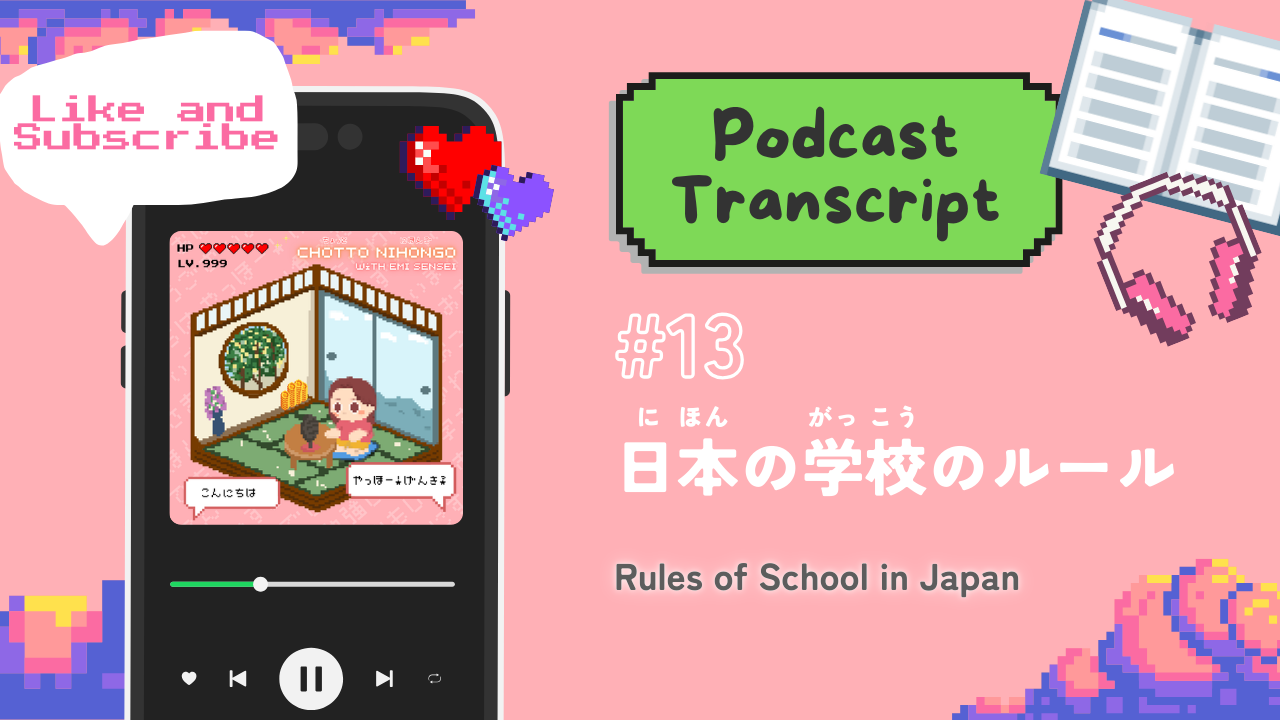
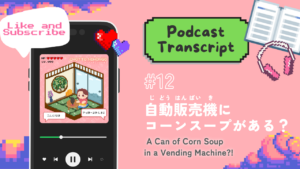
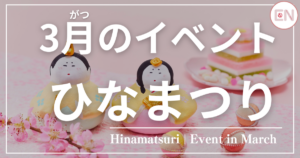
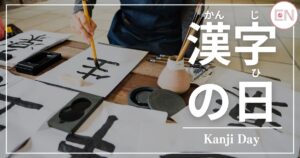
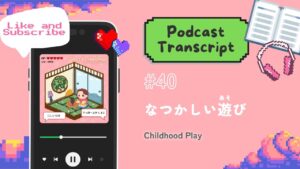
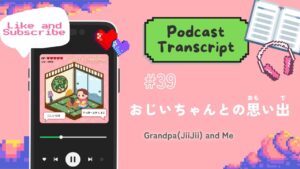

コメント|Comment